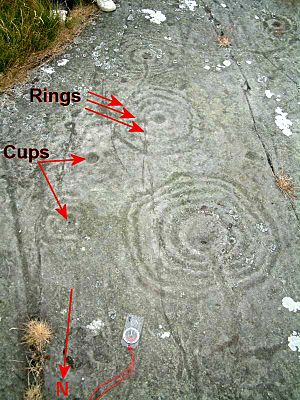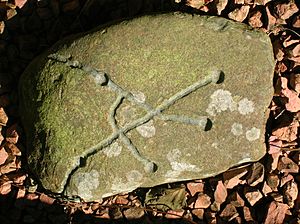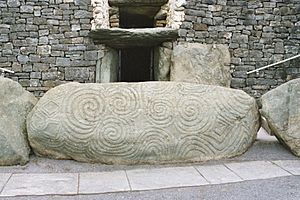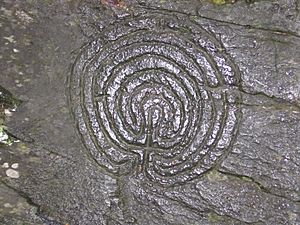Neolithic and Bronze Age rock art in the British Isles facts for kids


Imagine ancient people drawing pictures on rocks! This is called rock art, and it was made across the British Isles during the Neolithic (New Stone Age) and Bronze Age. Most of these carvings are abstract, meaning they don't show real objects. They are usually cup and ring marks, which are circles and hollows carved into stone. Sometimes, you can also find spirals or pictures of weapons.
This type of rock art is unique to Europe. It has connections to similar art found along the Atlantic Europe coast, especially in a place called Galicia. Most of the people who first studied this rock art were not professional archaeologists. They were often just interested people who loved history!
We believe that the rock art we see today is only a small part of what was made long ago. Many carvings might have worn away over time. Also, some art might have been painted on rocks or drawn on things that don't last, like wood, animals, or even people's bodies. These types of art would not have survived until today.
Contents
When Was This Art Made?
Rock art first started appearing in Atlantic Europe around 4,000 BCE (Before Common Era). This means it's over 6,000 years old!
In Britain, people stopped making rock art by the Late Bronze Age. This was around the first millennium BCE, when farming became much more common.
Where Can We Find Rock Art?
Northern Britain
Most of the ancient rock art in Britain is found in the northern part of the island. Cup-and-ring marks are very common here.
These cup-and-ring marks are usually from the Neolithic and Early Bronze Ages. Experts have tried to figure out the exact order in which they were made in places like Dumbartonshire.
South West Britain
More than 70 examples of ancient rock art have been found in the South West of Britain. This is much less than in the North. One reason might be that the rocks here are very hard, mostly granite. Also, not as much research has been done in this area. Some experts think the art here is different from the art in the North.
Most of the rock carvings in South West Britain are simple cup marks. These are carved both onto large rock faces and on smaller boulders, like at the Castallack Menhir.
Archaeologists have found three places in South West Britain where weapons are carved into the rocks. These are at the Boscawen-un stone circle in Cornwall, at Badbury Rings Barrow in Dorset, and at Stonehenge in Wiltshire. The weapons at Boscawen-un are thought to be from around 2000 BCE. Those at Badbury Rings and Stonehenge are a bit newer, from about 1800 BCE.
Some amazing labyrinth carvings have also been found in South West Britain. The most famous ones are a pair found on a shale rock at Rocky Valley, Cornwall. These seem to have been carved with metal tools. Some people think they are from the Bronze Age because they look like other ancient labyrinths in Galicia. However, many researchers believe they are much newer, perhaps from the 16th to 18th centuries. They argue that the carvings are too well-preserved to be thousands of years old.
Ireland

Cup-and-ring marks are also very common in Ireland. You can find many of them in areas like Fermnanagh/Donegal, Wicklow/Carlow, Louth/Monaghan, Cork, and Kerry. The Dingle and Iveragh peninsulas in Kerry have a huge number of these rock art panels.
You can even find these carvings on very old Neolithic burial mounds called passage tombs, like the famous Newgrange.
Who Studied This Art?
Across the British Isles, most of the early research into rock art was done by people who were not professional archaeologists. They were often passionate amateurs.
In 1997, an archaeologist named Richard Bradley wrote a book called Rock Art and the Prehistory of Atlantic Europe. This was the first big study of these carvings across all of Atlantic Europe. Later, in 1999, Stan Beckensall wrote British Prehistoric Rock Art, which was the first overview of all the rock art in Britain.
What Was the Purpose of Rock Art?
People have wondered for a long time why ancient people made these rock carvings. One researcher found 104 different ideas about their purpose! It's also possible that the meaning of the art changed over time. Later communities might have seen the art and used it for their own purposes, even if they didn't know its original meaning.
Guiding the Way?
Some researchers think that the cup marks in Britain might have been like signs. They could have been placed along paths to help guide people traveling through the landscape.
Visions and Meanings?
Another idea is that the patterns in the rock art might be images of phosphenes. These are patterns that people sometimes see when their eyes are closed or when they are in a special state of mind, like a trance.
This idea was first suggested for the carvings on Neolithic monuments by David Lewis-Williams. He noted that phosphenes can appear to anyone because they come from how our brains and eyes work. He and David Pearce wrote more about this in their book Inside the Neolithic Mind. Richard Bradley also thought that the circular designs on outdoor rock art might have shown a path leading into the rock itself.
Even if the very first rock art was based on these visions, the meaning might have changed as people copied the designs in other places.
Watery Symbols?
Some experts also believe that cup-and-ring marks were connected to water. Water was very important and sacred to people in ancient times. They noticed that some of the larger cups would collect rainwater. They also thought that the cup-and-ring marks looked like the ripples you see when a raindrop hits water.
See also
- List of Stone Age art


